Analyzing Acute Exacerbations in Asthma: A Case Study in Healthcare
VerifiedAdded on 2020/12/09
|9
|2047
|127
Case Study
AI Summary
This case study focuses on a patient named Jackson Smith who is experiencing an acute exacerbation of asthma. It explores the pathogenesis of asthma, including airway inflammation and bronchial hypersensitivity, and details the clinical manifestations observed in the patient. The assignment analyzes the causes of asthma, including allergens and triggers, and discusses the symptoms experienced by patients. It outlines the nursing strategies used to manage the patient, including initial assessment and emergency interventions, and provides rationales for these strategies. The assignment also examines the mechanism of action and nursing implications of drugs such as nebulized salbutamol, nebulized ipratropium bromide, and IV hydrocortisone. The document includes references to relevant books, journals, and online resources to support the analysis.
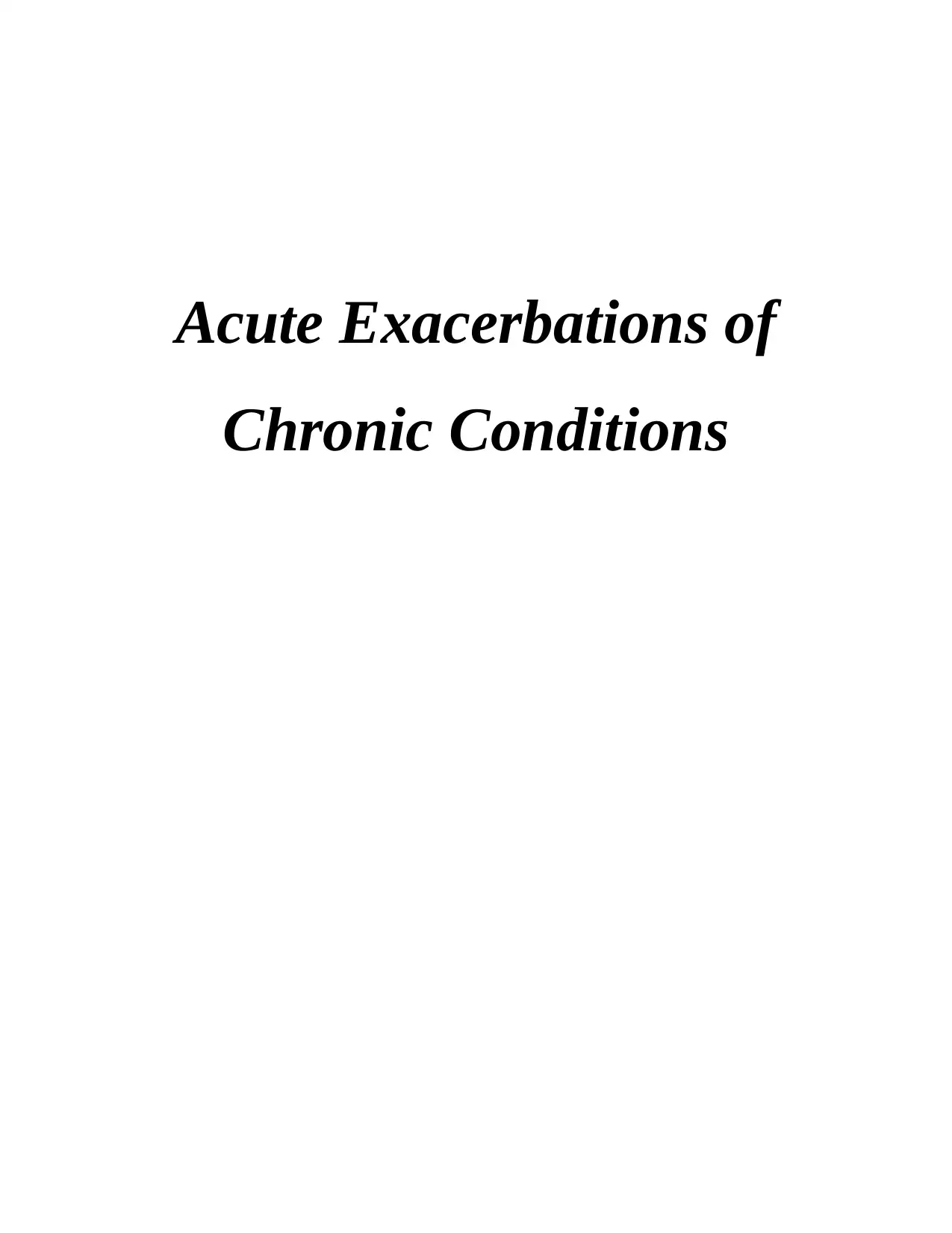
Acute Exacerbations of
Chronic Conditions
Chronic Conditions
Paraphrase This Document
Need a fresh take? Get an instant paraphrase of this document with our AI Paraphraser
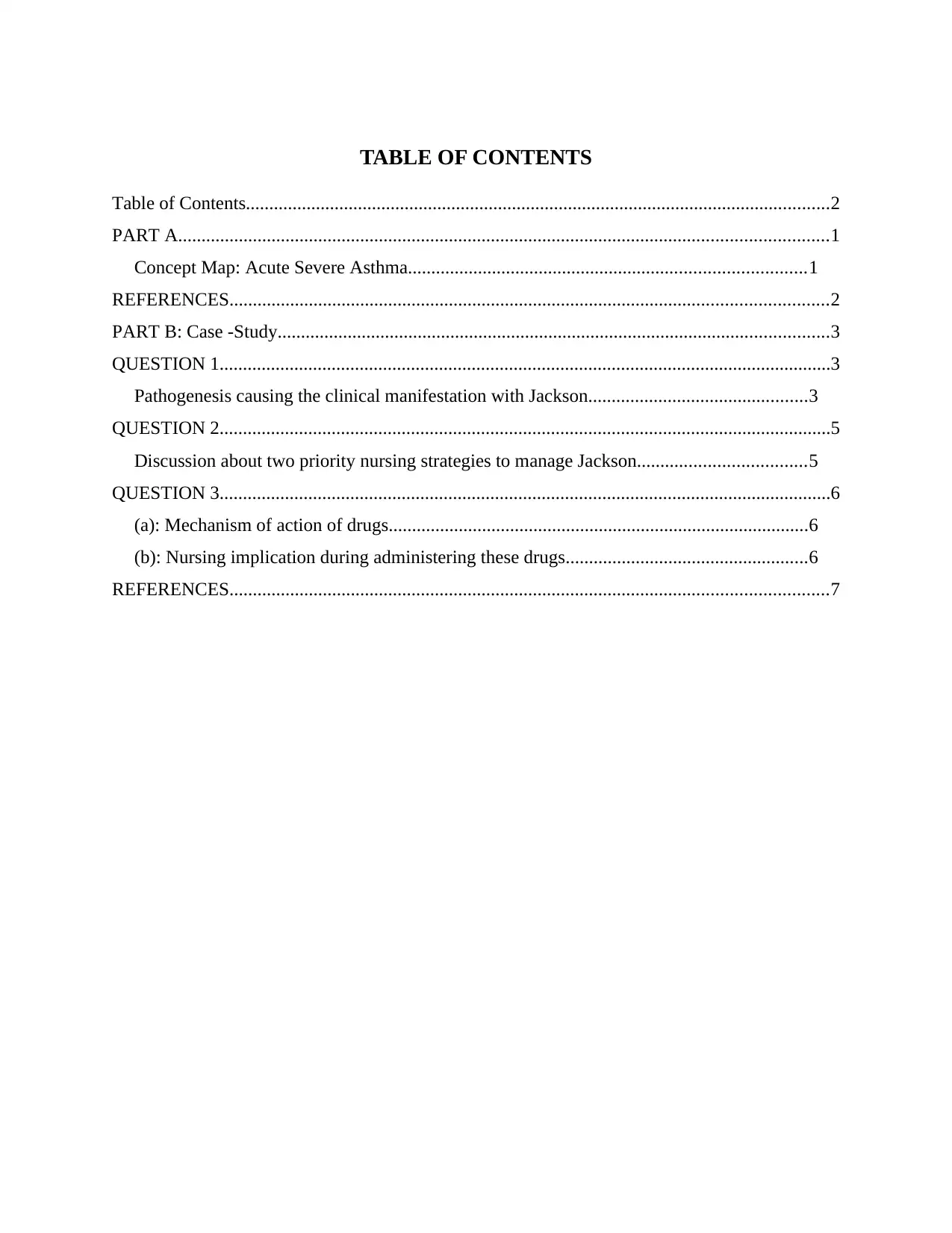
TABLE OF CONTENTS
Table of Contents.............................................................................................................................2
PART A...........................................................................................................................................1
Concept Map: Acute Severe Asthma.....................................................................................1
REFERENCES................................................................................................................................2
PART B: Case -Study......................................................................................................................3
QUESTION 1...................................................................................................................................3
Pathogenesis causing the clinical manifestation with Jackson...............................................3
QUESTION 2...................................................................................................................................5
Discussion about two priority nursing strategies to manage Jackson....................................5
QUESTION 3...................................................................................................................................6
(a): Mechanism of action of drugs..........................................................................................6
(b): Nursing implication during administering these drugs....................................................6
REFERENCES................................................................................................................................7
Table of Contents.............................................................................................................................2
PART A...........................................................................................................................................1
Concept Map: Acute Severe Asthma.....................................................................................1
REFERENCES................................................................................................................................2
PART B: Case -Study......................................................................................................................3
QUESTION 1...................................................................................................................................3
Pathogenesis causing the clinical manifestation with Jackson...............................................3
QUESTION 2...................................................................................................................................5
Discussion about two priority nursing strategies to manage Jackson....................................5
QUESTION 3...................................................................................................................................6
(a): Mechanism of action of drugs..........................................................................................6
(b): Nursing implication during administering these drugs....................................................6
REFERENCES................................................................................................................................7
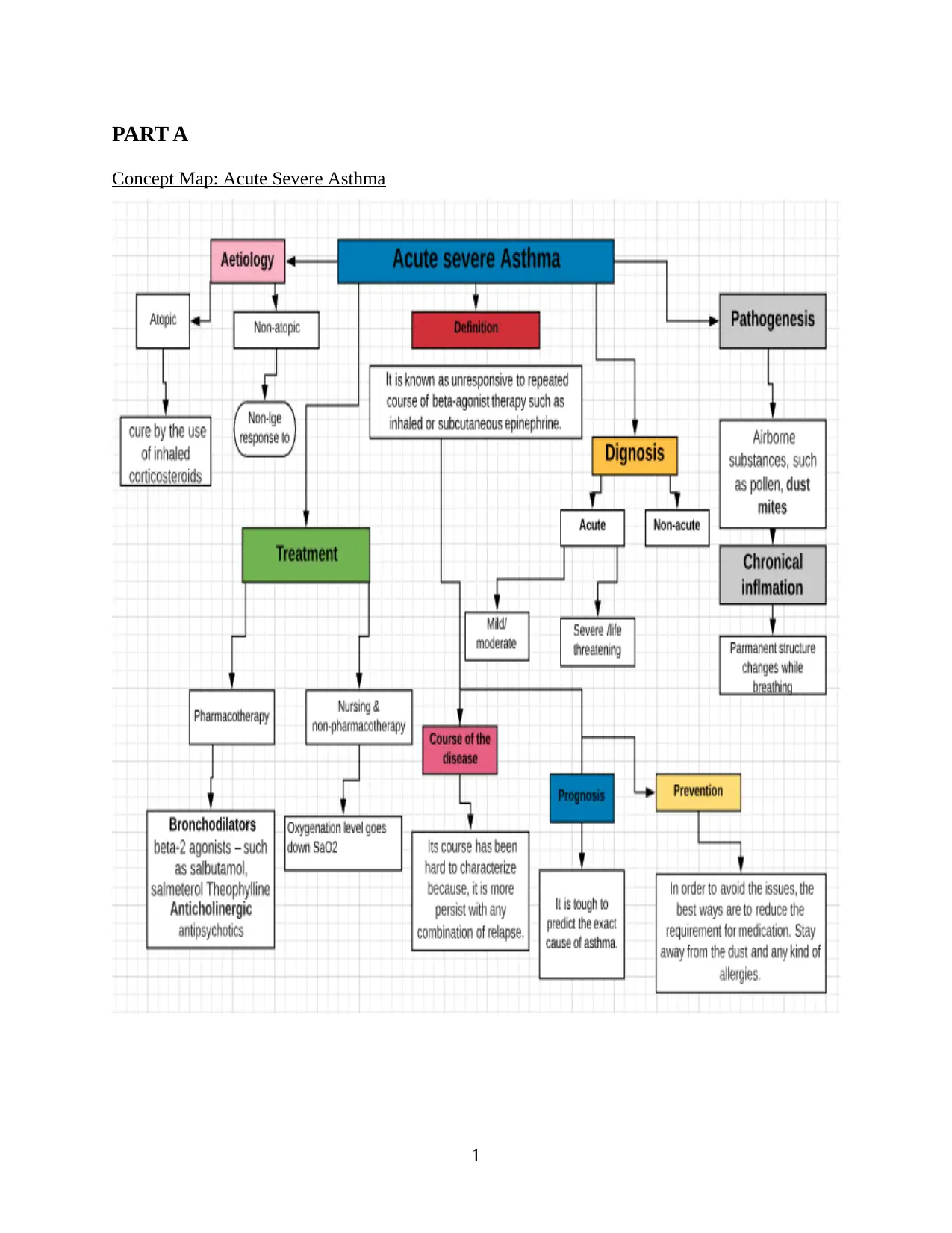
PART A
Concept Map: Acute Severe Asthma
1
Concept Map: Acute Severe Asthma
1
⊘ This is a preview!⊘
Do you want full access?
Subscribe today to unlock all pages.

Trusted by 1+ million students worldwide
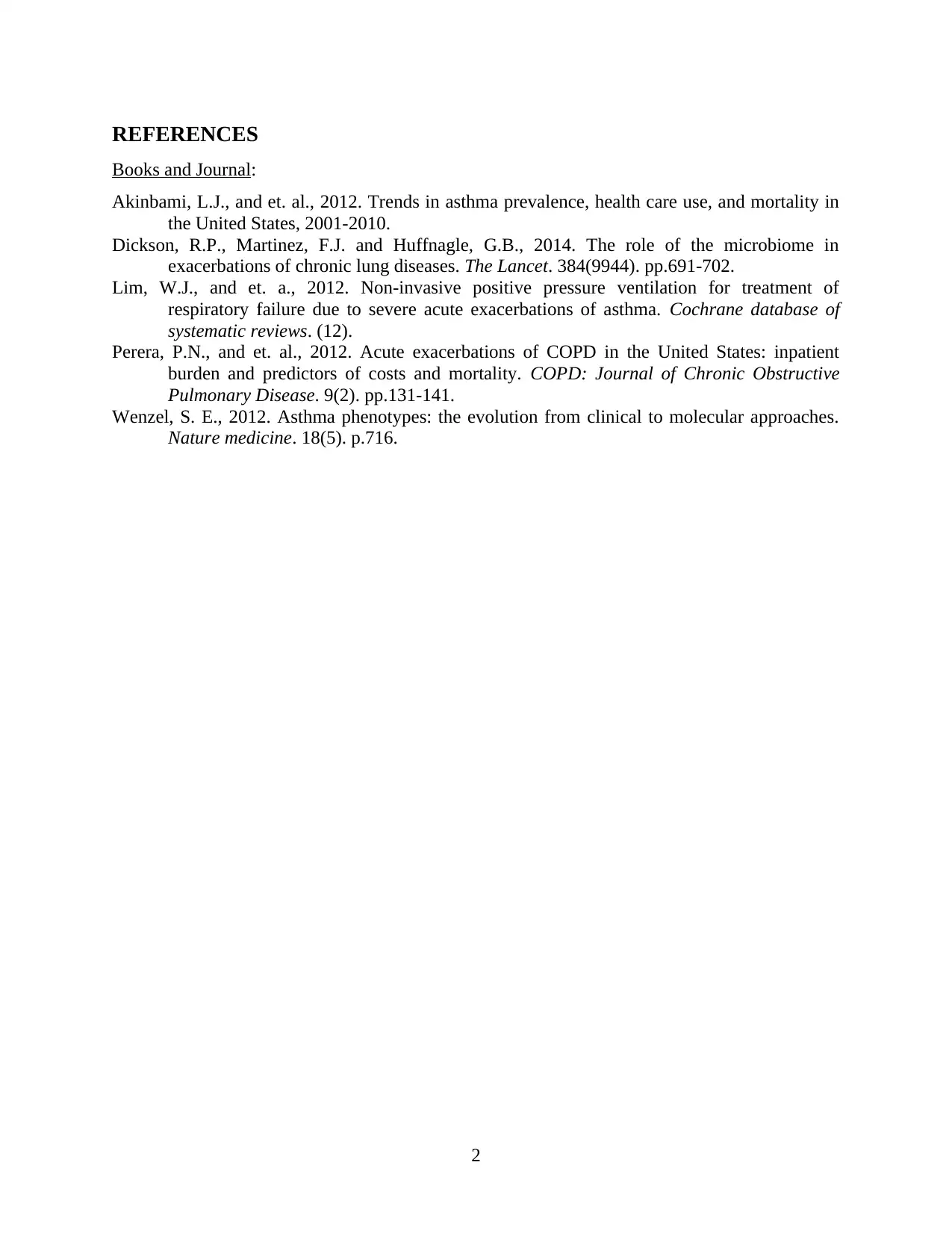
REFERENCES
Books and Journal:
Akinbami, L.J., and et. al., 2012. Trends in asthma prevalence, health care use, and mortality in
the United States, 2001-2010.
Dickson, R.P., Martinez, F.J. and Huffnagle, G.B., 2014. The role of the microbiome in
exacerbations of chronic lung diseases. The Lancet. 384(9944). pp.691-702.
Lim, W.J., and et. a., 2012. Non‐invasive positive pressure ventilation for treatment of
respiratory failure due to severe acute exacerbations of asthma. Cochrane database of
systematic reviews. (12).
Perera, P.N., and et. al., 2012. Acute exacerbations of COPD in the United States: inpatient
burden and predictors of costs and mortality. COPD: Journal of Chronic Obstructive
Pulmonary Disease. 9(2). pp.131-141.
Wenzel, S. E., 2012. Asthma phenotypes: the evolution from clinical to molecular approaches.
Nature medicine. 18(5). p.716.
2
Books and Journal:
Akinbami, L.J., and et. al., 2012. Trends in asthma prevalence, health care use, and mortality in
the United States, 2001-2010.
Dickson, R.P., Martinez, F.J. and Huffnagle, G.B., 2014. The role of the microbiome in
exacerbations of chronic lung diseases. The Lancet. 384(9944). pp.691-702.
Lim, W.J., and et. a., 2012. Non‐invasive positive pressure ventilation for treatment of
respiratory failure due to severe acute exacerbations of asthma. Cochrane database of
systematic reviews. (12).
Perera, P.N., and et. al., 2012. Acute exacerbations of COPD in the United States: inpatient
burden and predictors of costs and mortality. COPD: Journal of Chronic Obstructive
Pulmonary Disease. 9(2). pp.131-141.
Wenzel, S. E., 2012. Asthma phenotypes: the evolution from clinical to molecular approaches.
Nature medicine. 18(5). p.716.
2
Paraphrase This Document
Need a fresh take? Get an instant paraphrase of this document with our AI Paraphraser
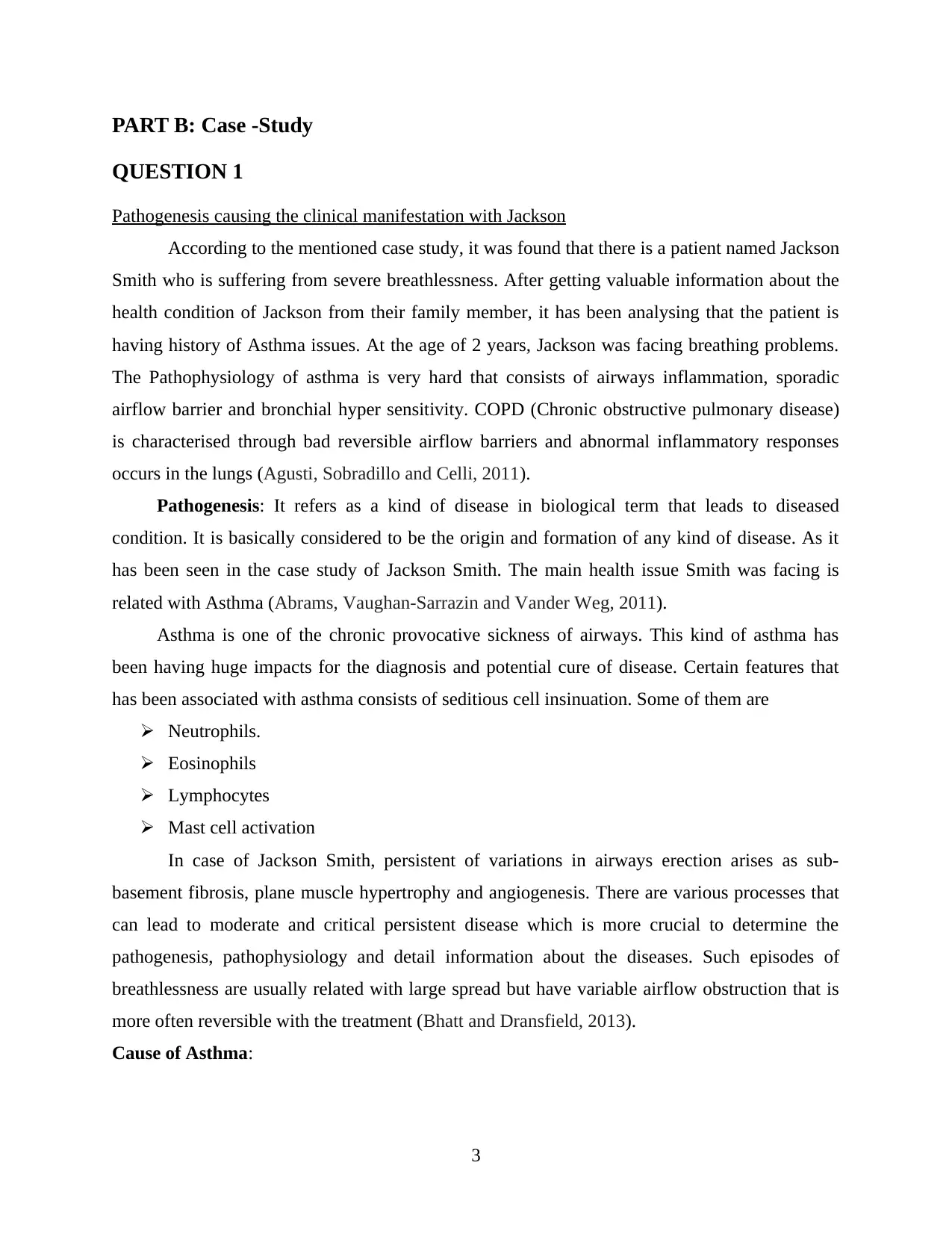
PART B: Case -Study
QUESTION 1
Pathogenesis causing the clinical manifestation with Jackson
According to the mentioned case study, it was found that there is a patient named Jackson
Smith who is suffering from severe breathlessness. After getting valuable information about the
health condition of Jackson from their family member, it has been analysing that the patient is
having history of Asthma issues. At the age of 2 years, Jackson was facing breathing problems.
The Pathophysiology of asthma is very hard that consists of airways inflammation, sporadic
airflow barrier and bronchial hyper sensitivity. COPD (Chronic obstructive pulmonary disease)
is characterised through bad reversible airflow barriers and abnormal inflammatory responses
occurs in the lungs (Agusti, Sobradillo and Celli, 2011).
Pathogenesis: It refers as a kind of disease in biological term that leads to diseased
condition. It is basically considered to be the origin and formation of any kind of disease. As it
has been seen in the case study of Jackson Smith. The main health issue Smith was facing is
related with Asthma (Abrams, Vaughan-Sarrazin and Vander Weg, 2011).
Asthma is one of the chronic provocative sickness of airways. This kind of asthma has
been having huge impacts for the diagnosis and potential cure of disease. Certain features that
has been associated with asthma consists of seditious cell insinuation. Some of them are
Neutrophils.
Eosinophils
Lymphocytes
Mast cell activation
In case of Jackson Smith, persistent of variations in airways erection arises as sub-
basement fibrosis, plane muscle hypertrophy and angiogenesis. There are various processes that
can lead to moderate and critical persistent disease which is more crucial to determine the
pathogenesis, pathophysiology and detail information about the diseases. Such episodes of
breathlessness are usually related with large spread but have variable airflow obstruction that is
more often reversible with the treatment (Bhatt and Dransfield, 2013).
Cause of Asthma:
3
QUESTION 1
Pathogenesis causing the clinical manifestation with Jackson
According to the mentioned case study, it was found that there is a patient named Jackson
Smith who is suffering from severe breathlessness. After getting valuable information about the
health condition of Jackson from their family member, it has been analysing that the patient is
having history of Asthma issues. At the age of 2 years, Jackson was facing breathing problems.
The Pathophysiology of asthma is very hard that consists of airways inflammation, sporadic
airflow barrier and bronchial hyper sensitivity. COPD (Chronic obstructive pulmonary disease)
is characterised through bad reversible airflow barriers and abnormal inflammatory responses
occurs in the lungs (Agusti, Sobradillo and Celli, 2011).
Pathogenesis: It refers as a kind of disease in biological term that leads to diseased
condition. It is basically considered to be the origin and formation of any kind of disease. As it
has been seen in the case study of Jackson Smith. The main health issue Smith was facing is
related with Asthma (Abrams, Vaughan-Sarrazin and Vander Weg, 2011).
Asthma is one of the chronic provocative sickness of airways. This kind of asthma has
been having huge impacts for the diagnosis and potential cure of disease. Certain features that
has been associated with asthma consists of seditious cell insinuation. Some of them are
Neutrophils.
Eosinophils
Lymphocytes
Mast cell activation
In case of Jackson Smith, persistent of variations in airways erection arises as sub-
basement fibrosis, plane muscle hypertrophy and angiogenesis. There are various processes that
can lead to moderate and critical persistent disease which is more crucial to determine the
pathogenesis, pathophysiology and detail information about the diseases. Such episodes of
breathlessness are usually related with large spread but have variable airflow obstruction that is
more often reversible with the treatment (Bhatt and Dransfield, 2013).
Cause of Asthma:
3
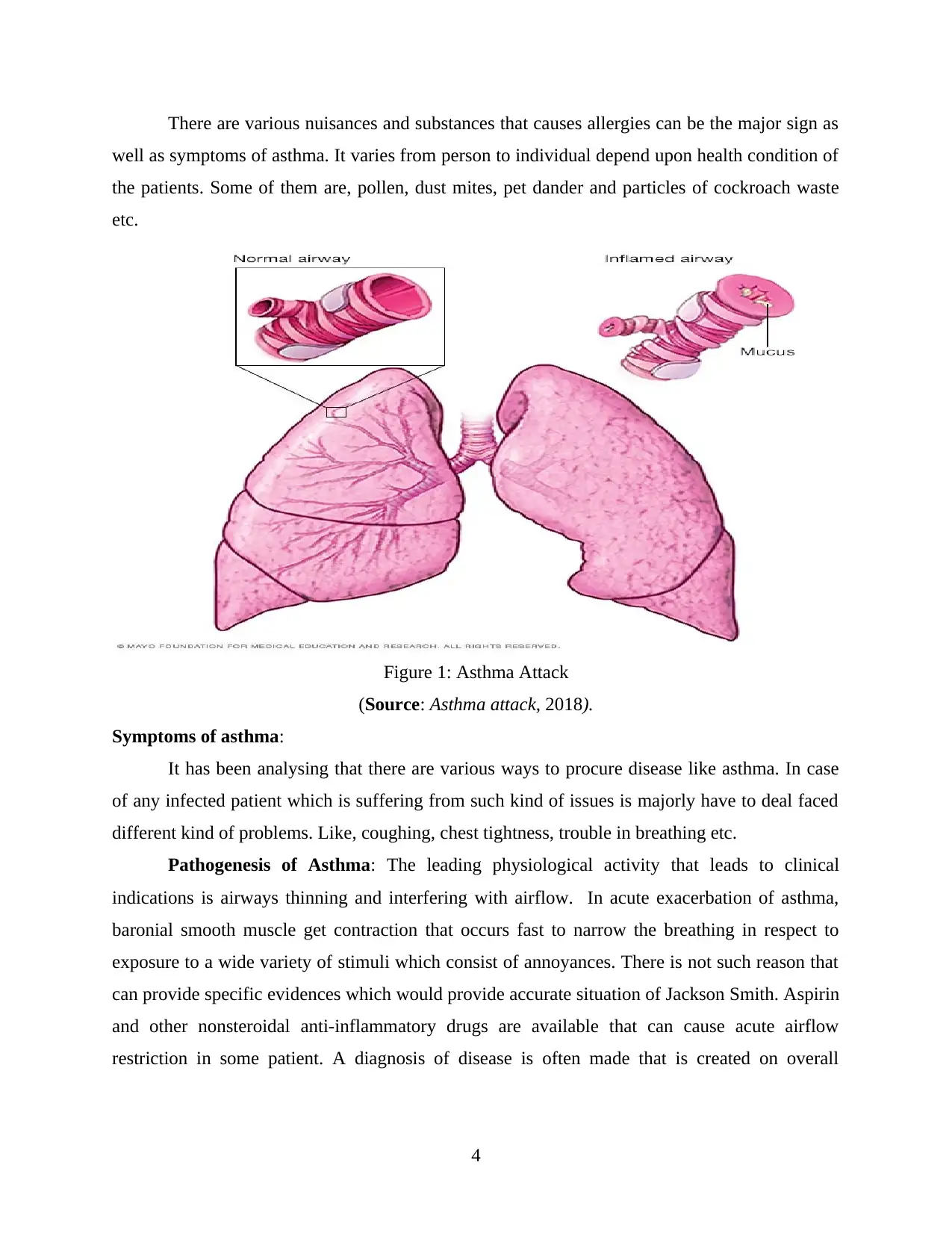
There are various nuisances and substances that causes allergies can be the major sign as
well as symptoms of asthma. It varies from person to individual depend upon health condition of
the patients. Some of them are, pollen, dust mites, pet dander and particles of cockroach waste
etc.
Figure 1: Asthma Attack
(Source: Asthma attack, 2018).
Symptoms of asthma:
It has been analysing that there are various ways to procure disease like asthma. In case
of any infected patient which is suffering from such kind of issues is majorly have to deal faced
different kind of problems. Like, coughing, chest tightness, trouble in breathing etc.
Pathogenesis of Asthma: The leading physiological activity that leads to clinical
indications is airways thinning and interfering with airflow. In acute exacerbation of asthma,
baronial smooth muscle get contraction that occurs fast to narrow the breathing in respect to
exposure to a wide variety of stimuli which consist of annoyances. There is not such reason that
can provide specific evidences which would provide accurate situation of Jackson Smith. Aspirin
and other nonsteroidal anti-inflammatory drugs are available that can cause acute airflow
restriction in some patient. A diagnosis of disease is often made that is created on overall
4
well as symptoms of asthma. It varies from person to individual depend upon health condition of
the patients. Some of them are, pollen, dust mites, pet dander and particles of cockroach waste
etc.
Figure 1: Asthma Attack
(Source: Asthma attack, 2018).
Symptoms of asthma:
It has been analysing that there are various ways to procure disease like asthma. In case
of any infected patient which is suffering from such kind of issues is majorly have to deal faced
different kind of problems. Like, coughing, chest tightness, trouble in breathing etc.
Pathogenesis of Asthma: The leading physiological activity that leads to clinical
indications is airways thinning and interfering with airflow. In acute exacerbation of asthma,
baronial smooth muscle get contraction that occurs fast to narrow the breathing in respect to
exposure to a wide variety of stimuli which consist of annoyances. There is not such reason that
can provide specific evidences which would provide accurate situation of Jackson Smith. Aspirin
and other nonsteroidal anti-inflammatory drugs are available that can cause acute airflow
restriction in some patient. A diagnosis of disease is often made that is created on overall
4
⊘ This is a preview!⊘
Do you want full access?
Subscribe today to unlock all pages.

Trusted by 1+ million students worldwide
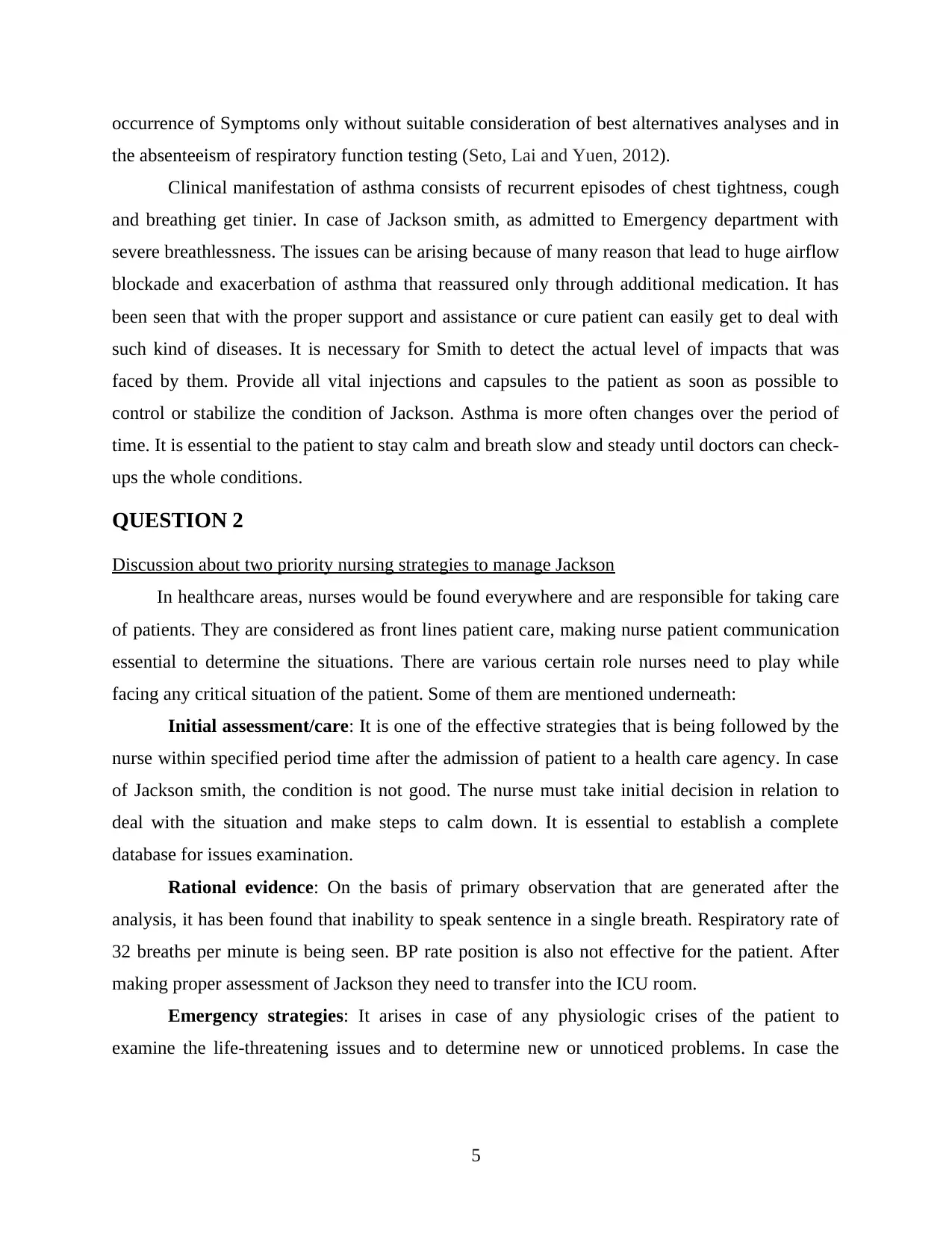
occurrence of Symptoms only without suitable consideration of best alternatives analyses and in
the absenteeism of respiratory function testing (Seto, Lai and Yuen, 2012).
Clinical manifestation of asthma consists of recurrent episodes of chest tightness, cough
and breathing get tinier. In case of Jackson smith, as admitted to Emergency department with
severe breathlessness. The issues can be arising because of many reason that lead to huge airflow
blockade and exacerbation of asthma that reassured only through additional medication. It has
been seen that with the proper support and assistance or cure patient can easily get to deal with
such kind of diseases. It is necessary for Smith to detect the actual level of impacts that was
faced by them. Provide all vital injections and capsules to the patient as soon as possible to
control or stabilize the condition of Jackson. Asthma is more often changes over the period of
time. It is essential to the patient to stay calm and breath slow and steady until doctors can check-
ups the whole conditions.
QUESTION 2
Discussion about two priority nursing strategies to manage Jackson
In healthcare areas, nurses would be found everywhere and are responsible for taking care
of patients. They are considered as front lines patient care, making nurse patient communication
essential to determine the situations. There are various certain role nurses need to play while
facing any critical situation of the patient. Some of them are mentioned underneath:
Initial assessment/care: It is one of the effective strategies that is being followed by the
nurse within specified period time after the admission of patient to a health care agency. In case
of Jackson smith, the condition is not good. The nurse must take initial decision in relation to
deal with the situation and make steps to calm down. It is essential to establish a complete
database for issues examination.
Rational evidence: On the basis of primary observation that are generated after the
analysis, it has been found that inability to speak sentence in a single breath. Respiratory rate of
32 breaths per minute is being seen. BP rate position is also not effective for the patient. After
making proper assessment of Jackson they need to transfer into the ICU room.
Emergency strategies: It arises in case of any physiologic crises of the patient to
examine the life-threatening issues and to determine new or unnoticed problems. In case the
5
the absenteeism of respiratory function testing (Seto, Lai and Yuen, 2012).
Clinical manifestation of asthma consists of recurrent episodes of chest tightness, cough
and breathing get tinier. In case of Jackson smith, as admitted to Emergency department with
severe breathlessness. The issues can be arising because of many reason that lead to huge airflow
blockade and exacerbation of asthma that reassured only through additional medication. It has
been seen that with the proper support and assistance or cure patient can easily get to deal with
such kind of diseases. It is necessary for Smith to detect the actual level of impacts that was
faced by them. Provide all vital injections and capsules to the patient as soon as possible to
control or stabilize the condition of Jackson. Asthma is more often changes over the period of
time. It is essential to the patient to stay calm and breath slow and steady until doctors can check-
ups the whole conditions.
QUESTION 2
Discussion about two priority nursing strategies to manage Jackson
In healthcare areas, nurses would be found everywhere and are responsible for taking care
of patients. They are considered as front lines patient care, making nurse patient communication
essential to determine the situations. There are various certain role nurses need to play while
facing any critical situation of the patient. Some of them are mentioned underneath:
Initial assessment/care: It is one of the effective strategies that is being followed by the
nurse within specified period time after the admission of patient to a health care agency. In case
of Jackson smith, the condition is not good. The nurse must take initial decision in relation to
deal with the situation and make steps to calm down. It is essential to establish a complete
database for issues examination.
Rational evidence: On the basis of primary observation that are generated after the
analysis, it has been found that inability to speak sentence in a single breath. Respiratory rate of
32 breaths per minute is being seen. BP rate position is also not effective for the patient. After
making proper assessment of Jackson they need to transfer into the ICU room.
Emergency strategies: It arises in case of any physiologic crises of the patient to
examine the life-threatening issues and to determine new or unnoticed problems. In case the
5
Paraphrase This Document
Need a fresh take? Get an instant paraphrase of this document with our AI Paraphraser
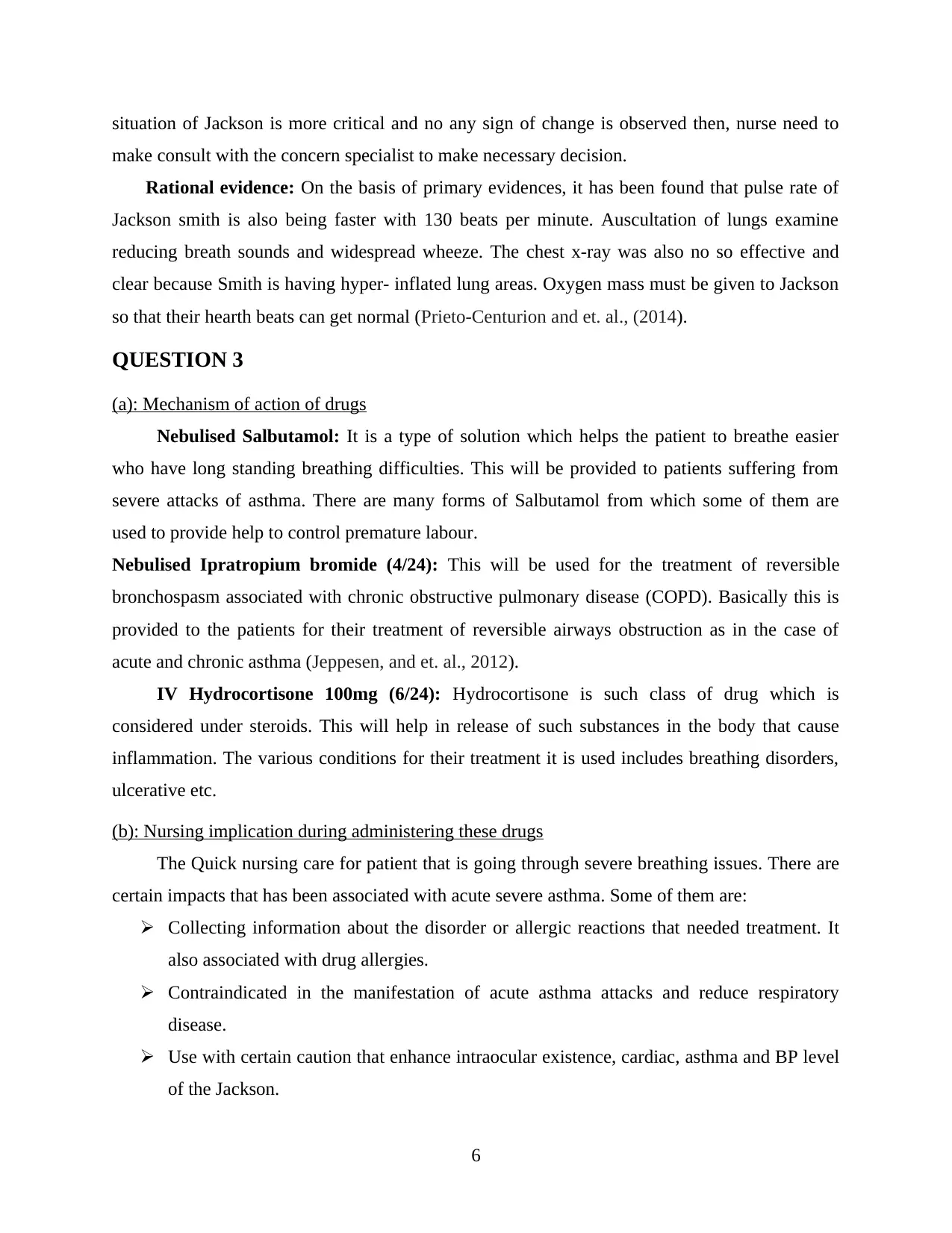
situation of Jackson is more critical and no any sign of change is observed then, nurse need to
make consult with the concern specialist to make necessary decision.
Rational evidence: On the basis of primary evidences, it has been found that pulse rate of
Jackson smith is also being faster with 130 beats per minute. Auscultation of lungs examine
reducing breath sounds and widespread wheeze. The chest x-ray was also no so effective and
clear because Smith is having hyper- inflated lung areas. Oxygen mass must be given to Jackson
so that their hearth beats can get normal (Prieto-Centurion and et. al., (2014).
QUESTION 3
(a): Mechanism of action of drugs
Nebulised Salbutamol: It is a type of solution which helps the patient to breathe easier
who have long standing breathing difficulties. This will be provided to patients suffering from
severe attacks of asthma. There are many forms of Salbutamol from which some of them are
used to provide help to control premature labour.
Nebulised Ipratropium bromide (4/24): This will be used for the treatment of reversible
bronchospasm associated with chronic obstructive pulmonary disease (COPD). Basically this is
provided to the patients for their treatment of reversible airways obstruction as in the case of
acute and chronic asthma (Jeppesen, and et. al., 2012).
IV Hydrocortisone 100mg (6/24): Hydrocortisone is such class of drug which is
considered under steroids. This will help in release of such substances in the body that cause
inflammation. The various conditions for their treatment it is used includes breathing disorders,
ulcerative etc.
(b): Nursing implication during administering these drugs
The Quick nursing care for patient that is going through severe breathing issues. There are
certain impacts that has been associated with acute severe asthma. Some of them are:
Collecting information about the disorder or allergic reactions that needed treatment. It
also associated with drug allergies.
Contraindicated in the manifestation of acute asthma attacks and reduce respiratory
disease.
Use with certain caution that enhance intraocular existence, cardiac, asthma and BP level
of the Jackson.
6
make consult with the concern specialist to make necessary decision.
Rational evidence: On the basis of primary evidences, it has been found that pulse rate of
Jackson smith is also being faster with 130 beats per minute. Auscultation of lungs examine
reducing breath sounds and widespread wheeze. The chest x-ray was also no so effective and
clear because Smith is having hyper- inflated lung areas. Oxygen mass must be given to Jackson
so that their hearth beats can get normal (Prieto-Centurion and et. al., (2014).
QUESTION 3
(a): Mechanism of action of drugs
Nebulised Salbutamol: It is a type of solution which helps the patient to breathe easier
who have long standing breathing difficulties. This will be provided to patients suffering from
severe attacks of asthma. There are many forms of Salbutamol from which some of them are
used to provide help to control premature labour.
Nebulised Ipratropium bromide (4/24): This will be used for the treatment of reversible
bronchospasm associated with chronic obstructive pulmonary disease (COPD). Basically this is
provided to the patients for their treatment of reversible airways obstruction as in the case of
acute and chronic asthma (Jeppesen, and et. al., 2012).
IV Hydrocortisone 100mg (6/24): Hydrocortisone is such class of drug which is
considered under steroids. This will help in release of such substances in the body that cause
inflammation. The various conditions for their treatment it is used includes breathing disorders,
ulcerative etc.
(b): Nursing implication during administering these drugs
The Quick nursing care for patient that is going through severe breathing issues. There are
certain impacts that has been associated with acute severe asthma. Some of them are:
Collecting information about the disorder or allergic reactions that needed treatment. It
also associated with drug allergies.
Contraindicated in the manifestation of acute asthma attacks and reduce respiratory
disease.
Use with certain caution that enhance intraocular existence, cardiac, asthma and BP level
of the Jackson.
6
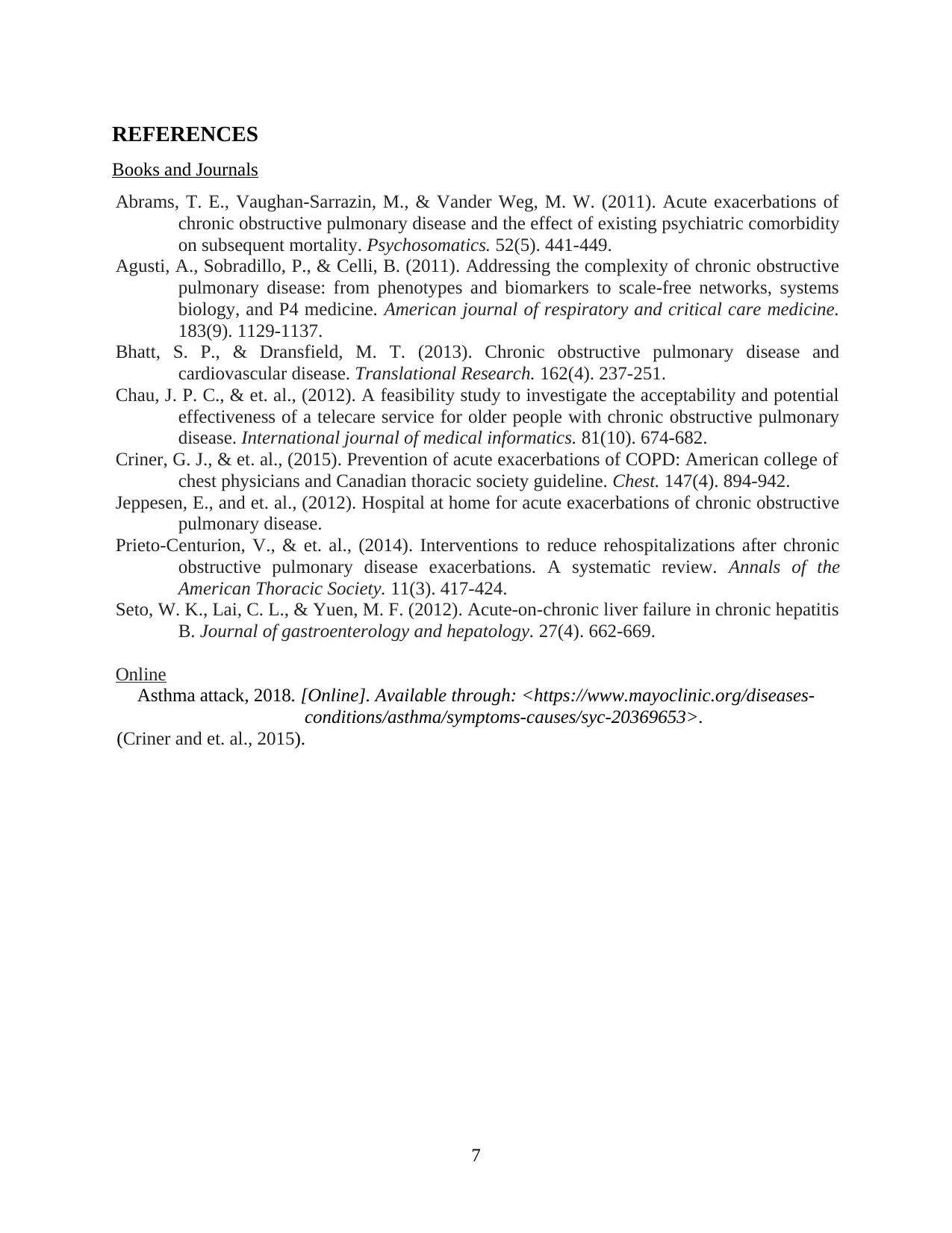
REFERENCES
Books and Journals
Abrams, T. E., Vaughan-Sarrazin, M., & Vander Weg, M. W. (2011). Acute exacerbations of
chronic obstructive pulmonary disease and the effect of existing psychiatric comorbidity
on subsequent mortality. Psychosomatics. 52(5). 441-449.
Agusti, A., Sobradillo, P., & Celli, B. (2011). Addressing the complexity of chronic obstructive
pulmonary disease: from phenotypes and biomarkers to scale-free networks, systems
biology, and P4 medicine. American journal of respiratory and critical care medicine.
183(9). 1129-1137.
Bhatt, S. P., & Dransfield, M. T. (2013). Chronic obstructive pulmonary disease and
cardiovascular disease. Translational Research. 162(4). 237-251.
Chau, J. P. C., & et. al., (2012). A feasibility study to investigate the acceptability and potential
effectiveness of a telecare service for older people with chronic obstructive pulmonary
disease. International journal of medical informatics. 81(10). 674-682.
Criner, G. J., & et. al., (2015). Prevention of acute exacerbations of COPD: American college of
chest physicians and Canadian thoracic society guideline. Chest. 147(4). 894-942.
Jeppesen, E., and et. al., (2012). Hospital at home for acute exacerbations of chronic obstructive
pulmonary disease.
Prieto-Centurion, V., & et. al., (2014). Interventions to reduce rehospitalizations after chronic
obstructive pulmonary disease exacerbations. A systematic review. Annals of the
American Thoracic Society. 11(3). 417-424.
Seto, W. K., Lai, C. L., & Yuen, M. F. (2012). Acute‐on‐chronic liver failure in chronic hepatitis
B. Journal of gastroenterology and hepatology. 27(4). 662-669.
Online
Asthma attack, 2018. [Online]. Available through: <https://www.mayoclinic.org/diseases-
conditions/asthma/symptoms-causes/syc-20369653>.
(Criner and et. al., 2015).
7
Books and Journals
Abrams, T. E., Vaughan-Sarrazin, M., & Vander Weg, M. W. (2011). Acute exacerbations of
chronic obstructive pulmonary disease and the effect of existing psychiatric comorbidity
on subsequent mortality. Psychosomatics. 52(5). 441-449.
Agusti, A., Sobradillo, P., & Celli, B. (2011). Addressing the complexity of chronic obstructive
pulmonary disease: from phenotypes and biomarkers to scale-free networks, systems
biology, and P4 medicine. American journal of respiratory and critical care medicine.
183(9). 1129-1137.
Bhatt, S. P., & Dransfield, M. T. (2013). Chronic obstructive pulmonary disease and
cardiovascular disease. Translational Research. 162(4). 237-251.
Chau, J. P. C., & et. al., (2012). A feasibility study to investigate the acceptability and potential
effectiveness of a telecare service for older people with chronic obstructive pulmonary
disease. International journal of medical informatics. 81(10). 674-682.
Criner, G. J., & et. al., (2015). Prevention of acute exacerbations of COPD: American college of
chest physicians and Canadian thoracic society guideline. Chest. 147(4). 894-942.
Jeppesen, E., and et. al., (2012). Hospital at home for acute exacerbations of chronic obstructive
pulmonary disease.
Prieto-Centurion, V., & et. al., (2014). Interventions to reduce rehospitalizations after chronic
obstructive pulmonary disease exacerbations. A systematic review. Annals of the
American Thoracic Society. 11(3). 417-424.
Seto, W. K., Lai, C. L., & Yuen, M. F. (2012). Acute‐on‐chronic liver failure in chronic hepatitis
B. Journal of gastroenterology and hepatology. 27(4). 662-669.
Online
Asthma attack, 2018. [Online]. Available through: <https://www.mayoclinic.org/diseases-
conditions/asthma/symptoms-causes/syc-20369653>.
(Criner and et. al., 2015).
7
⊘ This is a preview!⊘
Do you want full access?
Subscribe today to unlock all pages.

Trusted by 1+ million students worldwide
1 out of 9
Related Documents
Your All-in-One AI-Powered Toolkit for Academic Success.
+13062052269
info@desklib.com
Available 24*7 on WhatsApp / Email
![[object Object]](/_next/static/media/star-bottom.7253800d.svg)
Unlock your academic potential
Copyright © 2020–2025 A2Z Services. All Rights Reserved. Developed and managed by ZUCOL.





